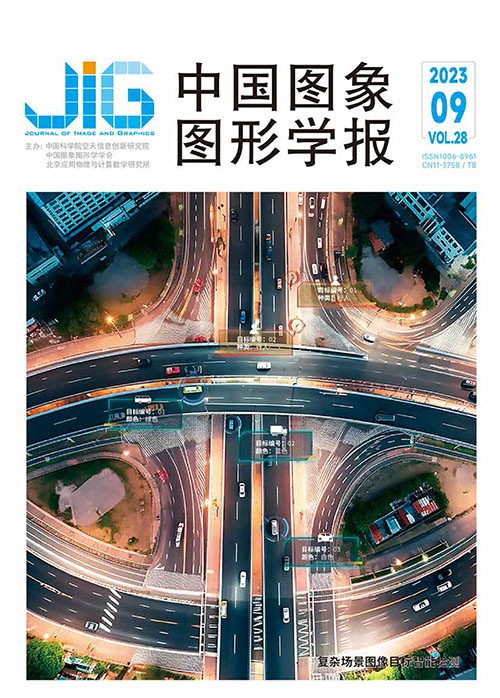
结合全局上下文与融合注意力的干涉相位去噪
曾庆旺1,2, 董张玉1,2,3, 杨学志2,3,4, 种法亭1,2(1.合肥工业大学计算机与信息学院, 合肥 230031;2.工业安全与应急技术安徽省重点实验室, 合肥 230031;3.智能互联系统安徽省实验室, 合肥 230031;4.合肥工业大学软件学院, 合肥 230031) 摘 要
目的 干涉相位去噪是合成孔径雷达干涉测量(interferometric synthetic aperture radar,InSAR)技术中的关键环节,其效果对测量精度具有重要影响。针对现有的干涉相位去噪方法大多关注局部特征以及在特征提取方面的局限性,同时为了平衡去噪和结构保持两者之间的关系,提出了一种结合全局上下文与融合注意力的相位去噪网络 GCFA-PDNet (global context and fused attention phase denoising network)。方法 将干涉相位分离为实部和虚部依次输入到网络,先从噪声相位中提取浅层特征,再将其映射到由全局上下文提取模块和融合注意力模块组成的特征增强模块,最后通过全局残差学习生成去噪图像。全局上下文提取模块能提取全局上下文信息,具有非局部方法的优势;融合注意力模块既强调关键特征,又能高效提取隐藏在复杂背景中的噪声信息。结果 所提出的方法与对比方法中性能最优者相比,在模拟数据结果的平均峰值信噪比(peak signal to noise ratio,PSNR)和结构相似性(struc-tural similarity,SSIM)指标分别提高了 5.72% 和 2.94%,在真实数据结果的平均残差点减少百分比(percentage ofresidual point reduction,PRR)和相位标准偏差(phase standard deviation,PSD)指标分别提高了 2.01% 和 3.57%。结合定性与定量分析,所提出的方法优于其他 5 种不同类型的相位去噪方法。结论 提出的去噪网络较其他方法具有更强大的特征提取能力,此外由于关注全局上下文信息和强调关键特征,网络能够在增强去噪能力的同时保持原始相位细节。
关键词
Interferometric phase denoising combining global context and fused attention
Zeng Qingwang1,2, Dong Zhangyu1,2,3, Yang Xuezhi2,3,4, Chong Fating1,2(1.College of Computer and Information, Hefei University of Technology, Hefei 230031, China;2.Anhui Province Key Laboratory of Industry Safety and Emergency Technology, Hefei 230031, China;3.Anhui Province Laboratory of Intelligent Interconnection System, Hefei 230031, China;4.College of Software, Hefei University of Technology, Hefei 230031, China) Abstract
Objective Interferometric phase noise is introduced by three types of inherent factors:1)system noise, such as thermal noise and synthetic aperture radar(SAR)speckle noise;2)decoherence problems, including baseline, temporal, and spatial decoherence;3)signal processing errors, such as misregistration.The existence of noise increases the difficulty of phase unwrapping and even causes the process to fail, thereby seriously interfering with the final interferometric result.Therefore, interferometric phase denoising is a key link in interferometric SAR(InSAR)technology.Its effect has an important influence on the accuracy of measurement results.The existing interferometric phase denoising algorithms still have many defects.First is the insufficient ability to capture global contextual information.Some algorithms ignore global context information or only focus on local context information derived from a few pixels.They also lack global context information.This feature is manifested as unstable detail preservation ability in denoising results.Second, many researchers only pay attention to the influence of the spatial dimension or channel dimension of the image on the denoising result to improve the performance of denoising networks.However, they do not use spatial and channel dimensions in combination.Third, the high-level features extracted from the deep layers of the convolutional neural network have rich semantic information and ambiguous spatial details.In comparison, the low-level features extracted from the shallow layers of the network contain considerable pixel-level noise information.However, these features are isolated from one another;thus, they cannot be fully used.Method Most of the existing interferometric phase denoising methods focus on local features, and they have many limitations in feature extraction.A phase denoising network called GCFA-PDNet is proposed to solve these problems while balancing the relationship between denoising and structure preservation.This proposed phase denoising network combines global context and fused attention.The method separates the interference phase into real and imaginary parts and inputs them into the network.First, the shallow features are extracted from the noise phase.Then, they are mapped to the feature enhancement module composed of the global context extraction module and the fused attention module.The shallow features extracted by the network are fused with the deep features concurrently.Finally, a denoised image is generated through global residual learning.Four global context extraction modules and four fused attention modules are used in the whole network.The core module of the global context extraction module is the global context block, which can extract the global context information and has the advantages of nonlocal methods.The fused attention module fuses the features extracted by its two submodules:the channel attention block and the spatial attention block.It emphasizes key features and efficiently extracts noise information hidden in complex backgrounds.Result We present six experimental results:Goldstein, nonlocal interferogram estimator(NL-InSAR), block-matching 3D(InSAR-BM3D), a deep learning framework for SAR interferometric phase restoration and coherence estimation (DeepInSAR), phase filtering network, and GCFAPDNet.Different evaluation indicators are selected for different datasets to evaluate the advantages and disadvantages of various algorithms objectively.For the experiments of simulated images, peak signal-to-noise ratio(PSNR)and structural similarity(SSIM)are selected as evaluation indicators.A large PSNR indicates a little difference between the filtered phase and the clean phase.However, it does not consider the correlation between pixels in the image.Therefore, SSIM is employed to assess the SSIM of the filtered images to evaluate the overall denoising quality of the denoised images.Compared with the comparative methods, the proposed method improves the average PSNR and SSIM indicators of the simulated data results by 5.72% and 2.94%, respectively.For the real interference phase, the above two indicators cannot be used for evaluating the denoising performance because no noise-free image is used as a reference.The number of residues (NOR)and phase standard deviation(PSD)can also be used as objective evaluation indicators to judge subjectively the denoising performance of real interferometric phase images.NOR can reflect the ability of the filtering method to suppress noise.The smaller the NOR of the filtered interference phase is, the stronger the ability to suppress noise is.PSD can be used to measure the discrete degree of noise distribution.The smaller the PSD value is, the more concentrated the noise distribution is and the better the quality of the interferogram is.In the real data results, compared with the comparative methods, the proposed method increases the average percentage of residual point reduction and PSD indicators by 2.01% and 3.57%, respectively.The visual observation of the experimental results of various algorithms shows that the proposed method achieves the best denoising results.The qualitative and quantitative analyses also indicate that the proposed method outperforms the five other types of phase denoising methods.Conclusion The phase denoising network designed in the present study combines the global context and fused attention.Thus, it has certain advantages compared with other related algorithms.It also has a more powerful feature extraction ability than other methods.The network focuses on global context information and emphasizes key features.Thus, it can maintain the original phase details while enhancing the denoising ability, thereby achieving the best denoising results.
Keywords
synthetic aperture radar interferometry(InSAR) interferometric phase denoising residual learning global context fused attention
|



 中国图象图形学报 │ 京ICP备05080539号-4 │ 本系统由
中国图象图形学报 │ 京ICP备05080539号-4 │ 本系统由